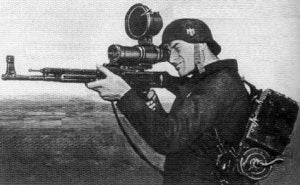Sightmark’s Best Tactical Scopes
At Sightmark, we design each optic to meet a specific need in the shooting world—whether that be for plinking, 3-Gun competition, hunting or high-stakes professional work. Each scope or red dot sight incorporates meticulously thought-out features specific to that optic’s purpose.
Some use the word “tactical” as a meaningless buzz word to sell products. With many military veterans on our team, as well as retired and active law enforcement, we don’t throw words like “tactical” and “MIL-SPEC” around. When we market something as such, we mean it. When we use the word “tactical,” we’re referring to any feature inspired by a military design. From precision sniper accuracy to quick target acquisition in CQB, Sightmark makes purpose-driven reflex sights, as well as long-range magnified riflescopes for true tactical use.
What is a Tactical Scope?

It used to be easier to distinguish between a hunting scope and a tactical scope, yet recently, the lines are blurring. A traditional hunting scope used to be characterized by being simpler than a tactical scope, with moderate magnification range, a simple crosshair reticle, low-profile turrets and construction that withstands recoil and bad weather but not necessarily rated for the type of abuse a tactical scope endures.
A close- to mid-range tactical scope typically has a second focal plane, range-finding (milliradian) reticles, large target turrets with audible click adjustments, and must be durable for rough use in harsh environments.
Hunters are beginning to see the benefits of tactical-style features and demanding superb low-light performance, range-estimating reticles and large windage and elevation turrets.
You really can’t distinguish between a tactical and non-tactical scope just by looking at it. You can though, deduce use when looking at the scope’s specifications. Because the most effective shots for hunting are at a limited range, most hunting scopes will not go past 10x magnification but tactical scopes, especially those designed for long-range shooting can have powerful magnifications.
As noted above, Sightmark makes tactical optics for CQB to long-range. Here are the top five tactical scopes:
AR Riflescopes

The AR and M1 series of riflescopes are specifically designed for AR-15s and other Modern Sporting Rifles with a rugged hard-anodized 6061-T6 aluminum tube that is shockproof, (nitrogen-filled) fogproof and IP67 waterproof-rated and feature illuminated reticles.
The AR scopes are available in varying magnifications from 1-4x to 5-10x with 20mm, 32mm and 40mm objectives. You can choose between a.300 Blackout, .223, or .308 Winchester second focal plane reticle, all of which compensate for bullet drop.
Unique to this series of tactical scopes is the rapid power rotation eyepiece for quick target acquisition, especially when there are fast-moving targets. Ten brightness adjustments transition this scope smoothly from low-light to bright-light environments.
Large, exposed pop-up locking turrets keep your scope zeroed.
Perfect for close to mid-ranges, the AR scopes provide tactical shooters with precision accuracy and fast, positive target acquisition.
Find your AR scope by clicking here.
Pinnacle 5-30×50 TMD Riflescope

For extreme long-range distances, the 5-30x50mm Pinnacle riflescope will make your shot count out to 1,000 yards and further. Zero stop elevation easily helps you set a stopping point at a certain range, meaning a return to zero every single time you use your scope.
The combination of the 34mm tube and 50mm objective lens increases elevation adjustment range, light transmission and field of view for a clear image, as well as more accurate long-range shot placement.
An advanced TMD-HW first focal plane illuminated (red or green) tactical MIL reticle helps estimate range and holdovers for bullet drop, crosswind and moving targets.
The Pinnacle boasts a tested and recommended rating from the National Tactical Officers Association.
Ultra Shot M-Spec LQD Sight

With a tactical 2 MOA dot, the Ultra Shot M-Spec (MIL-SPEC) reflex red dot sight is made for the AR-15 and other Modern Sporting Rifles and has 10 brightness settings, is night-vision compatible and has a patented integrated sunshade.
Guaranteed with a lifetime warranty, the Ultra Shot is shockproof, dustproof, IP68 waterproof-rated, recoil-rated up to .338 Winchester Magnum and constructed of lightweight yet rugged 6061-T6 aluminum.
Specialized features include up to 2,000-hour battery life, a battery-saving automatic on and off activation, digital controls and a locking quick-detach Picatinny mount.
Citadel 1-6x24mm CR1

The 1-6x magnification range makes the Citadel CR1 ideal for close-quarters one-shot accuracy, as well as quick acquisition of targets at mid-range distances. It features a second focal plane BDC reticle calibrated for 55-grain .223 ammo with red illumination to aid in low-light situations and ½ MOA click adjustments.
Built for rough use, the Citadel is constructed of aluminum and is IP67 waterproof—submersible to 1 meter for 1 hour, plus shockproof and fogproof.
Included are a throw lever and flip-up lens caps.
Click here to check out the Citadel.
Mini Shot M-SPEC LQD

For a versatile reflex sight, the Mini Shot M-SPEC transitions smoothly from pistols to your tactical shotgun or rifle. Included is a low-profile quick-detach mount, as well as a riser mount for your AR-15.
The most popular dot size, the 3 MOA dot is the sweet spot between CQB and mid-range, making the Mini Shot accurate for any tactical situation you encounter. It has double the battery life of the competition with up to an impressive 30,000 hours battery life. The 12-hour automatic shutoff means you don’t have to worry about failure when you need speed and precision the most.
The Mini red dot features 1 MOA windage and elevation click adjustments for easy zeroing, 10 brightness adjustments for both indoor and outdoor environments and ambidextrous digital controls.
The Sightmark Mini Shot M-SPEC LQD red dot sight has been field-tested through the National Tactical Officers Association and comes recommended for law enforcement and professional use.
Click here to buy the Mini Shot.
From CQB to extreme long-range, Sightmark has an optic for when failure isn’t an option.

















